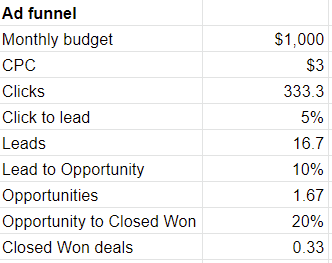If you’ve tried online advertising on Google, LinkedIn, Facebook and the likes, and have been disappointed by the results, you’re not alone. In this post, I’ll share why online paid campaigns simply aren’t for everyone.
If you’re a small, early stage B2B startup targeting Enterprise customers, I recommend skipping large paid online campaigns altogether, and focusing on other channels like content and email.
Before we dive into the reasons why, let me clarify that I’m not totally against online advertising. In fact, I often recommend setting up the following small-scale campaigns:
- Google search ads (Adwords) brand keyword campaign (i.e. covering your startup name and a small group of highly relevant keywords / competitor names if applicable)
- A retargeting campaign for site visitors over Display and Search.
Depending on keyword and visitor volume, this setup shouldn’t amount to more than a couple hundred dollars a month, and it’s very low maintenance. So even if you don’t see direct ROI, you can treat it as a low-investment branding campaign.
What I don’t recommend is a large investment of money and time in setting up elaborate paid campaigns on Google, Facebook, and LinkedIn for early-stage B2B startups selling to Enterprise. The ROI isn’t there and you’ll waste a lot of time and money in the process.
The reasons large-scale paid campaigns for early stage B2B startups selling to Enterprise don’t work
1) Expensive. There’s no way around it — these channels get very expensive in terms of CAC (Customer Acquisition Cost). You might be saying, “It’s OK, I’m in Enterprise and my deal ACV (Average Contract Value) is really high, so I can afford higher CAC.”
The problem with this argument is that the Enterprise sales cycle is long, and your data set is small. A year from now, you might end up with a CAC that’s even higher than your target CAC — sometimes infinitely so, if you’re not able to close any deals.
Our tip? Closely watch your leading indicators, like leads and opportunities, to make sure your CPL (cost per lead) and CPO (Cost per Opportunity) don’t exceed your targets. More in this post: Is my CPL too high?
2) Small budget + small data set + long sales cycle → You can’t even prove whether the channel is working. Related to the first point, let’s do a simple math exercise. Suppose your monthly ad budget is $1K, not too shabby for a small startup just beginning to work with paid channels. For simplicity, let’s assume your average CPC across all online paid channels is $3. Let’s look at the resulting funnel, making some conversion rate assumptions with benchmarks from our clients:

This means that even if assumed conversion rates actually happen, you’ll need to invest $3K to get just one deal (0.33X3). Until then, you won’t know if the channel is not performing because you don’t have enough leads yet or because actual performance doesn’t measure up to your assumptions.
In addition, this simplistic funnel doesn’t show the time lag between leads, opportunities, and closed won deals – which can easily amount to months or even years. This means you’ll need to wait a long time to assess your ROI. Do you continue spending in the meantime, hoping the spend will be justified six months down the road? That could be very costly. Or should you use predictive analytics to assess your lead quality from the get go? That’s complicated and not always accurate.
Ultimately, it boils down to this: There’s no point in running small-scale paid campaigns. They’re not effective and won’t teach you anything.
3) Time intensive & high opportunity cost. Even if you can make the marginal CAC worth it, is the time investment worthwhile? Often the limiting factor for startups isn’t money, it’s the team’s bandwidth. Creating and optimizing online ad campaigns is very time consuming. A good campaign requires hands-on management and optimization, nothing is “set & forget” nowadays. You need to become a media expert, intimately understand the different channels, keep up to date with changes, write effective ad copy, build high-performance landing pages, and proactively manage your bids. Even if you outsource this to an agency, you will still need to invest a significant amount of time managing it. Is it worth investing in the channel at the expense of others, like content, email, even conferences?
One tip – when calculating CAC by channel, factor in time investment to understand the true cost.
4) Attribution. Enterprise sales almost always involve multiple marketing touchpoints before converting to a demo. How are you going to divvy up the credit if someone met you at a conference, attended a webinar, clicked an ad, and then requested a demo? Our recommendation for Last Click attribution makes things simpler, but perhaps too simple when paid campaigns are involved and the stakes are high. And trust me, you won’t be the one figuring out multi-touch attribution.
5) Let’s face it, the CMO of Macy’s isn’t going to buy off of your Google Ad. Think about your user journey. If you’re selling to Enterprise, nobody is signing the dotted line off of an ad, or off your website in general. The best outcome you can hope for is that they click “Get a Demo”… and even that is pretty unattainable the more senior your audience is. Thus, a common outcome startups aim for is Lead Generation—capturing a lead’s email address through a content-based landing page (e.g. “submit your email to download our ebook”). After you have the lead’s email, you need to nurture them all the way to a demo. Then, you’re in the gnarly attribution game again – how much credit should the initial ad get? You also need high-quality content that’s refreshed all the time for the ads to remain effective.
Even if you can do all that, online advertising is an extremely expensive channel for Enterprise Lead Generation. In Enterprise, the size of your target audience is fairly limited (e.g. “CMOs at Fortune 500 Retailers”). It’s way cheaper, faster, and easier to use tactics such as ABM (Account Based Marketing), list building, and email marketing/prospecting to build a database of all relevant leads and nurture them to a demo.
And last but not least – anecdotally, I have never met a startup marketing leader selling to Enterprises who said that paid digital marketing is killing it for them — and I have spoken to many.
The Bottom Line
Taking into account the caveats mentioned earlier, I don’t recommend investing a lot in online advertising. What can you do instead? We highly recommend diving into content, emails, and webinars as channels that can provide real value to your audience, and real leads — and customers — to you. We’ve written plenty about content and email if you’d like to dive deeper.
Hat tip to Naomi Sela, the best online advertising expert I know, for providing feedback on this post. If you’re looking to start large-scale advertising, there’s no one better.








